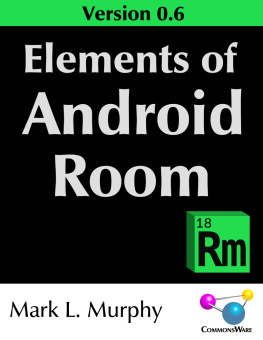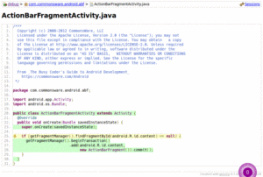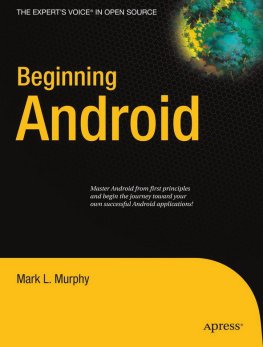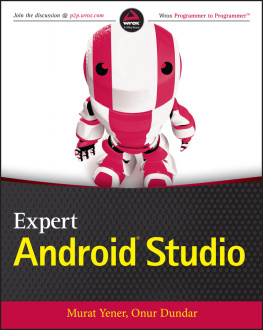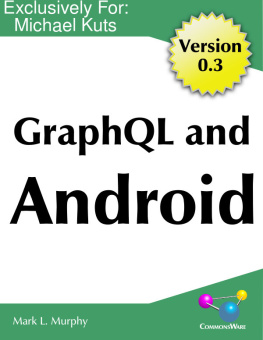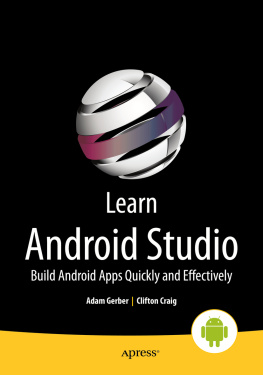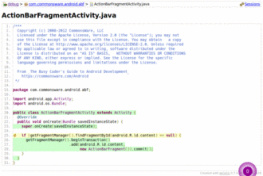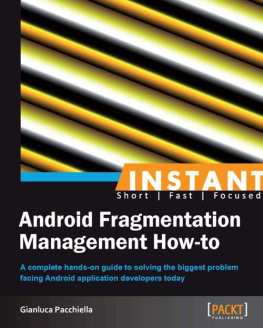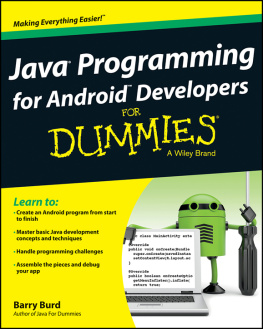Mark L. Murphy - Elements of Android Room Version 0.6
Here you can read online Mark L. Murphy - Elements of Android Room Version 0.6 full text of the book (entire story) in english for free. Download pdf and epub, get meaning, cover and reviews about this ebook. year: 2021, publisher: CommonsWare, genre: Home and family. Description of the work, (preface) as well as reviews are available. Best literature library LitArk.com created for fans of good reading and offers a wide selection of genres:
Romance novel
Science fiction
Adventure
Detective
Science
History
Home and family
Prose
Art
Politics
Computer
Non-fiction
Religion
Business
Children
Humor
Choose a favorite category and find really read worthwhile books. Enjoy immersion in the world of imagination, feel the emotions of the characters or learn something new for yourself, make an fascinating discovery.
- Book:Elements of Android Room Version 0.6
- Author:
- Publisher:CommonsWare
- Genre:
- Year:2021
- Rating:4 / 5
- Favourites:Add to favourites
- Your mark:
- 80
- 1
- 2
- 3
- 4
- 5
Elements of Android Room Version 0.6: summary, description and annotation
We offer to read an annotation, description, summary or preface (depends on what the author of the book "Elements of Android Room Version 0.6" wrote himself). If you haven't found the necessary information about the book — write in the comments, we will try to find it.
Elements of Android Room Version 0.6 — read online for free the complete book (whole text) full work
Below is the text of the book, divided by pages. System saving the place of the last page read, allows you to conveniently read the book "Elements of Android Room Version 0.6" online for free, without having to search again every time where you left off. Put a bookmark, and you can go to the page where you finished reading at any time.
Font size:
Interval:
Bookmark:
Headings formatted in bold-italic have changed since the last version.
Thanks!
Thanks for your interest in Room! Room is Googles solution for a high-level databaseaccess API, for your local SQLite databases. As such, Room gets a lot of attentionand is reasonably popular.
Thanks also for your broader interest in Android app development! Android is the most widely-usedoperating system on the planet, so we need to be able to rapidly develop high-qualityAndroid apps. Room can help with that.
And thanks for your interest in this book! Here, you can learn more about how to workwith Room, from the basics through more complex scenarios. And, along the way, theremay be a joke or two.
This book is designed for developers with at least a bit of Android app developmentexperience. If you are fairly new to Android, please consider readingElements of Android Jetpack,Exploring Android, or both, beforecontinuing with this book.
Also note that this books examples are written in Kotlin. If you are unfamiliarwith Kotlin, you can still learn stuff about Room from this book, though it willbe more difficult. You might consider reading Elements of Kotlin,to familiarize yourself with Kotlin.
If you obtained this book through, you will be able to downloadupdates as they become available, for the duration of your subscriptionperiod.
If you obtained this book through other channels um, well, its stilla really nice book!
Each release has notations to show what is new or changed compared with theimmediately preceding release:
- The Table of Contents in the ebook formats (PDF, EPUB, MOBI/Kindle) showssections with changes in bold-italic font
- Those sections have changebars on the right to denote specific paragraphsthat are new or modified
And, there is the Whats New section, just below this paragraph.
This update adds two more chapters, covering:
Also, was updated to Paging 3.
In addition:
- A bunch of dependencies were updated, notably Room itself
- Various bugs were fixed
If you purchased the Warescription, read on! If you obtained this book fromother channels, feel free to .
The Warescription entitles you, for the duration of your subscription, to digitaleditions of this book and its updates, in PDF, EPUB, and Kindle (MOBI/KF8) formats,plus the ability to read the book online at the Warescription Web site.You also have access to other books that CommonsWare publishes during thatsubscription period.
Each subscriber gets personalized editions of all editions of each title. That way,your books are never out of date for long, and youcan take advantage of new material as it is made available.
However, you can only download the books while you have an active Warescription.There is a grace period after your Warescription ends: you can stilldownload the book until the next book update comes out after yourWarescription ends. After that, you can no longer download the book.Hence, please download your updates as they come out.You can find out when new releasesof this book are available via:
- The CommonsBlog
- The CommonsWare Twitter feed
- Opting into emails announcing each book release log into theWarescription site and choose Configure fromthe nav bar
- Just check back on the Warescription site everymonth or two
Subscribers also have access to other benefits, including:
- Office hours online chats to help you getanswers to your Android application development questions. You will find a calendarfor these on your Warescription page.
- A Stack Overflow bump service, to get additional attention for a questionthat you have posted there that does not have an adequate answer.
- A discussion board for asking arbitrary questions about Android app development.
The source code in this book is licensed under theApache 2.0 License, in case you have thedesire to reuse any of it.
Copying source code directly from the book, in the PDF editions, works bestwith Adobe Reader, though it may also work with other PDF viewers. Some PDF viewers,for reasons that remain unclear, foul up copying the source code to the clipboardwhen it is selected.
Each CommonsWare book edition will be available for use under theCreative Commons Attribution-Noncommercial-ShareAlike 3.0license as of thefourth anniversary of its publication date, or when 4,000 copies of the editionhave been sold, whichever comes first. That means that, once four years haveelapsed (perhaps sooner!), you can use this prose for non-commercial purposes.That is our Four-to-Free Guarantee to our readers and the broader community.For the purposes of this guarantee, new Warescriptions and renewals will becounted as sales of this edition, starting from the time the edition ispublished.
This edition of this book will be available under the aforementioned CreativeCommons license on 1 August 2025. Of course, watch the CommonsWare Website, as this edition might be relicensed sooner based on sales.
For more details on the Creative Commons Attribution-Noncommercial-ShareAlike3.0 license, visit the Creative Commons Web site
Note that future editions of this book will become free on later dates, eachfour years from the publication of that edition or based on sales of thatspecific edition. Releasing one edition under the Creative Commons license doesnot automatically release all editions under that license.
The author would like to thank Daniel Rivera, Yiit Boyar, and the rest of thedevelopers at Google responsible for Room.
The author would also like to thank Stephen Lombardo, Nick Parker, and the restof Zetetic, plus Nathan Frietas, Hans-Cristoph Steiner, and the rest of the GuardianProject, for all their work on SQLCipher for Android and general Android appsecurity.
Google describes Room as providing an abstraction layer over SQLite to allowfluent database access while harnessing the full power of SQLite.
In other words, Room aims to make your use of SQLite easier, througha lightweight annotation-based implementation of anobject-relational mapping (ORM) engine.
If you have ever worked with a relational database like SQLite froman object-oriented language like Java or Kotlin undoubtedly you have encounteredthe object-relational impedance mismatch.That is a very fancy way of saying its a pain getting stuff intoand out of the database.
In object-oriented programming,we are used to objects holding references to other objects, forming some sortof object graph. However, traditional SQL-style relational databases workoff of tables of primitive data, using foreign keys and join tables toexpress relationships. Figuring out how to get our classes to map torelational tables is aggravating, and it usually results in a lot of boilerplatecode.
Traditional Android development uses SQLiteDatabase for interacting with SQLite.That, in turn, uses Cursor objects to represent the results of queries andContentValues objects to represent data to be inserted or updated. While Cursorand ContentValues are objects, they are fairly generic, much in the way thata HashMap or ArrayList is generic. In particular, neither Cursor norContentValues
Font size:
Interval:
Bookmark:
Similar books «Elements of Android Room Version 0.6»
Look at similar books to Elements of Android Room Version 0.6. We have selected literature similar in name and meaning in the hope of providing readers with more options to find new, interesting, not yet read works.
Discussion, reviews of the book Elements of Android Room Version 0.6 and just readers' own opinions. Leave your comments, write what you think about the work, its meaning or the main characters. Specify what exactly you liked and what you didn't like, and why you think so.

